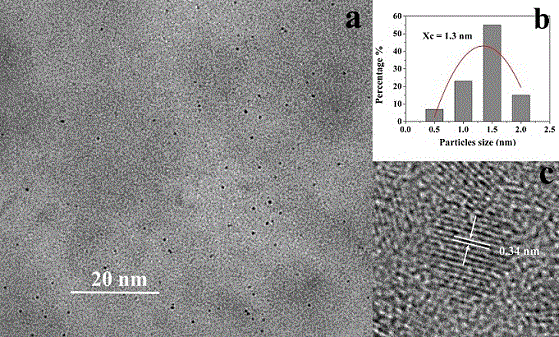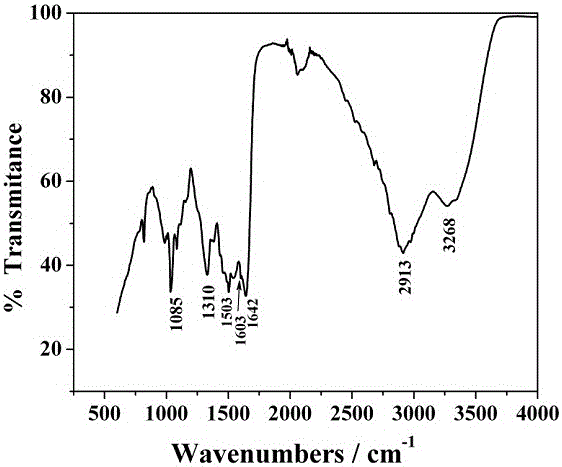Method of one-step synthesizing fluorescent carbon dots with corncob as carbon source
A technology of fluorescent carbon dots and corncob, applied in chemical instruments and methods, luminescent materials, etc., can solve problems such as inability to complete large-scale production, and achieve the effects of avoiding toxic reagents, mild reaction conditions, and cheap and readily available raw materials
- Summary
- Abstract
- Description
- Claims
- Application Information
AI Technical Summary
Problems solved by technology
Method used
Image
Examples
Embodiment 1
[0010] Take 0.1g of crushed, washed and dried corncob, 1.5mL of ethylenediamine and 10mL of deionized water, stir them evenly and place them in a 50mL autoclave at 100℃, 120℃, 150℃, 180℃, React at 190°C and 200°C for 6 hours to obtain a brownish-yellow solution. Place the obtained brownish-yellow solution in a centrifuge at a centrifugal rate of 12000r / min for 10min and filter it through a filter membrane with a pore size of 0.2μm. The resulting filtrate is fixed to 100mL In the volumetric flask, use a fluorescence spectrophotometer (FP-6500 fluorescence spectrometer, JASCO) to measure the fluorescence intensity of the resulting solution. The results are shown in Table 1.
[0011] Reaction temperature (℃)100120150180190200 The fluorescence intensity92150480666694658
[0012] It can be seen from Table 1 that as the temperature of the hydrothermal reaction increases, the fluorescence intensity of the obtained fluorescent carbon dots gradually increases, and reaches the maximum ...
Embodiment 2
[0014] Take 0.1g of crushed, washed and dried corncob, 1.5mL of ethylenediamine, and 10mL of deionized water, stir evenly and place in a 50mL autoclave, and react at 190℃ for 2h, 4h, 5h, 6h, 7h respectively And 10h to obtain a brown-yellow solution, place the obtained brown-yellow solution in a centrifuge at a centrifugal speed of 12000r / min for 10min and filter it through a filter membrane with a pore size of 0.2μm. The resulting filtrate is fixed in volume in a 100mL volumetric flask. The fluorescence intensity of the obtained solution was measured by a spectrophotometer (FP-6500 fluorescence spectrometer, Japan Branch Co., Ltd.). The results are shown in Table 2.
[0015] Response time (h)2456710 The fluorescence intensity58210640696644608
[0016] It can be seen from Table 2 that with the extension of the reaction time, the hydrothermal reaction gradually tends to be complete. When the reaction time is 6h, the fluorescence intensity reaches the maximum, so the optimal hyd...
Embodiment 3
[0018] Take 0.1g of crushed, washed and dried corncobs, add 0mL, 0.5mL, 1.0mL, 1.5mL and 2.0mL of ethylenediamine respectively, and then add 10mL of deionized water, stir well and place in 50mL high pressure reaction In the kettle, react at 190°C for 6 hours to obtain a brownish yellow solution. Place the obtained brownish yellow solution in a centrifuge at a centrifugal speed of 12000r / min for 10min and filter it through a filter membrane with a pore size of 0.2μm. Using a 100mL volumetric flask, use a fluorescence spectrophotometer (FP-6500 fluorescence spectrometer, Japan Branch) to measure the fluorescence intensity of the resulting solution. The results are shown in Table 3.
[0019] Ethylenediamine dosage (mL)00.51.01.52.0 The fluorescence intensity133316541698605
[0020] It can be seen from Table 3 that when the amount of ethylenediamine added is 1.5mL, the fluorescence intensity of the synthesized fluorescent carbon dots reaches the maximum, so the best dosage of eth...
PUM
 Login to View More
Login to View More Abstract
Description
Claims
Application Information
 Login to View More
Login to View More - R&D
- Intellectual Property
- Life Sciences
- Materials
- Tech Scout
- Unparalleled Data Quality
- Higher Quality Content
- 60% Fewer Hallucinations
Browse by: Latest US Patents, China's latest patents, Technical Efficacy Thesaurus, Application Domain, Technology Topic, Popular Technical Reports.
© 2025 PatSnap. All rights reserved.Legal|Privacy policy|Modern Slavery Act Transparency Statement|Sitemap|About US| Contact US: help@patsnap.com



